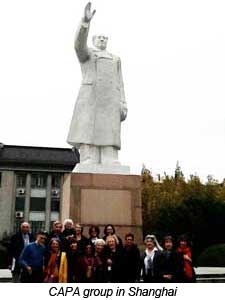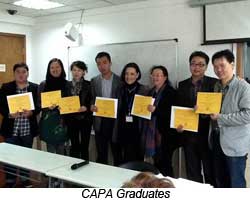 |
The International Association for Relational Psychoanalysis and Psychotherapy |
|
|
|
Not Your Momma's China
By Sally Rudoy
 |
 Elise Snyder, MD |
 |
Along with KFC, McDonalds, and Starbucks, China is importing psychoanalysis. I recently went on a multi-week study tour with the China American Psychoanalytic Alliance (CAPA). I was a bit taken aback at first at the wholesale adoption of all things western in China. For example, take women's fashion : Mao jackets have been replaced by form fitting blouses, 3” heels on unbound feet, and colorful mini skirts. George Clooney, Leonardo DiCaprio, and Kate Winslet appear larger than life on billboards advertising luxury products they would never dare hawk at home. Cell phones are as prolific as they are on the streets of New York. The irony, of course, is that most of these products are made in China although originally designed for western tastes. Consumerism is rampant.
Among young clinicians there is a great interest in psychoanalysis, particularly classical Freudian theory. While conversant in the psychoanalytic literature, they have little clinical experience or training in its practice. That is where CAPA steps in. Founded by Elise Snyder, MD in 2002, CAPA’s mission is to provide training in psychoanalytic psychotherapy to mental health clinicians in China.
Most of our contact was with psychiatrists, psychologists and counselors, who had trained with CAPA. In their papers and case presentations they displayed clinical competence and an understanding of psychoanalytic process and theory. By contrast, we visited a mental health clinic that had no affiliation with CAPA. I was on deck to do a live supervision with a young woman who worked there. We communicated through a translator in front of a large audience of young clinicians . I would speak a few sentences in English, wait for the translator to say what I said in Chinese, wait for her response in Chinese, and then for his translation back to me in English. We averaged about 2 minutes per exchange. This posed quite a challenge not just for the obvious reason of having to speak with so much delay between thoughts. It was a challenge because the material presented was shocking. The therapist anxiously presented a case of a patient with a sexual perversion that revolted me and, by the look on the scrunched up faces of our audience members, revolted them too. She was determined to help this young man who, to my ears, sounded psychotic or psychopathic. Containing (over 2 languages) what I believed to be her dissociated disgust and fear of this man, I steadied myself with two slow sentences at a time. I suggested she set firmer conditions and boundaries of the frame of the treatment, including a psychiatric evaluation and establishing conditions of safety.
A colleague, who had also done supervision with a non-CAPA trained therapist observed a similar phenomenon. There was an infatuation with meaning and symbolism that superseded the primary steps of establishing the frame and the therapeutic alliance.
Psychoanalysis aspires to help the patient find psychic freedom and choice, to find a balance between the pulls of inner and outer worlds. How would this process operate in a culture, accustomed to authoritarianism, conformity, and tightly constricted social norms? Yet, I also had begun to see what Elise Snyder termed the Chinese therapists’ “hunger” and need for training. Some of my American colleagues had very emotional in-person meetings with supervisees or analysands they had known intimately via Skype for months or even years. The Chinese therapists appeared sincerely grateful for the experience of their training. The rich exploration of the unconscious that psychoanalysis invites can tantalize the newcomer. Especially if knowledge comes from a book. However, it is in the interpersonal and the interactive engagement of class, analysis, and supervision (face to face; screen to screen) that the theory comes to life and ultimately can be helpful to patients. My CAPA experience underscored the value of psychoanalytic training, no matter what the culture.
Photo credits: Starbucks by Starr Kelton-Locke; McDonalds by Gillian Russell. Others by Sally Rudoy |
||

 It is this consumerism, in part, that has provided an incentive for Chinese therapists to seek training from outside the country's borders. More than ever before, with a rapidly rising middle class, the Chinese feel pressure to make money and to keep up with their neighbors. With this pressure has come an upsurge in mood disorders. The one child policy, initiated in 1978, has created generations prone to narcissism and overwhelming parental expectation. The legacy of trauma from the Cultural Revolution finds its way into every corner and generation of this country that has experienced more profound change in the last 30 years than the 2000 that proceeded.
It is this consumerism, in part, that has provided an incentive for Chinese therapists to seek training from outside the country's borders. More than ever before, with a rapidly rising middle class, the Chinese feel pressure to make money and to keep up with their neighbors. With this pressure has come an upsurge in mood disorders. The one child policy, initiated in 1978, has created generations prone to narcissism and overwhelming parental expectation. The legacy of trauma from the Cultural Revolution finds its way into every corner and generation of this country that has experienced more profound change in the last 30 years than the 2000 that proceeded.  Classes, supervision, and analyses are conducted via Skype by psychoanalysts around the world. Since all activities are conducted in English, participants must have a good command of the language. Skype is used because it is secure and confidential. As Elise Snyder says, it is also the communication tool of choice for the Mafia and top corporate CEO’s.
Classes, supervision, and analyses are conducted via Skype by psychoanalysts around the world. Since all activities are conducted in English, participants must have a good command of the language. Skype is used because it is secure and confidential. As Elise Snyder says, it is also the communication tool of choice for the Mafia and top corporate CEO’s.  She did not like what I had to say. She wanted my psychoanalytic musings on what caused him to do these things and how she could explain them to him. Internally, I questioned whether I was I hitting a cultural divide, displaying cultural insensitivity. Yes, there is something in the Chinese character that feels duty bound to finish any job started. However, I think it was the universal state that new therapists feel: “I have to help everyone who comes through the door or I have failed.”
She did not like what I had to say. She wanted my psychoanalytic musings on what caused him to do these things and how she could explain them to him. Internally, I questioned whether I was I hitting a cultural divide, displaying cultural insensitivity. Yes, there is something in the Chinese character that feels duty bound to finish any job started. However, I think it was the universal state that new therapists feel: “I have to help everyone who comes through the door or I have failed.” 